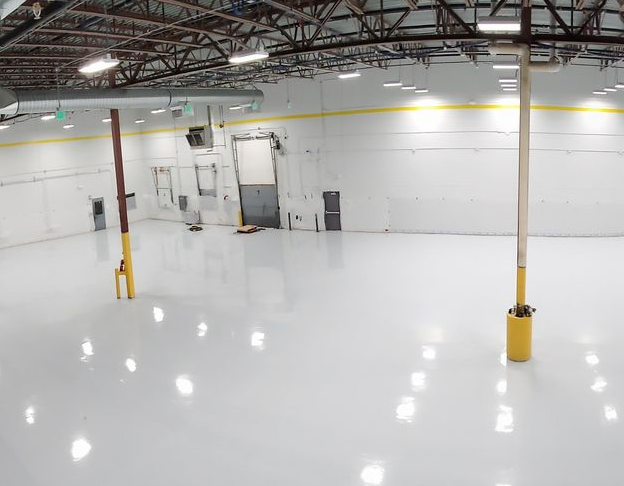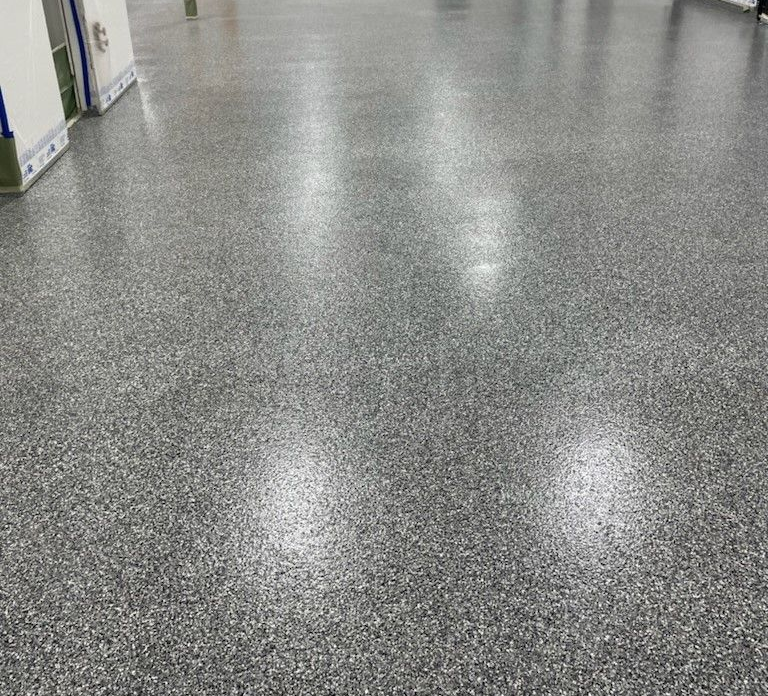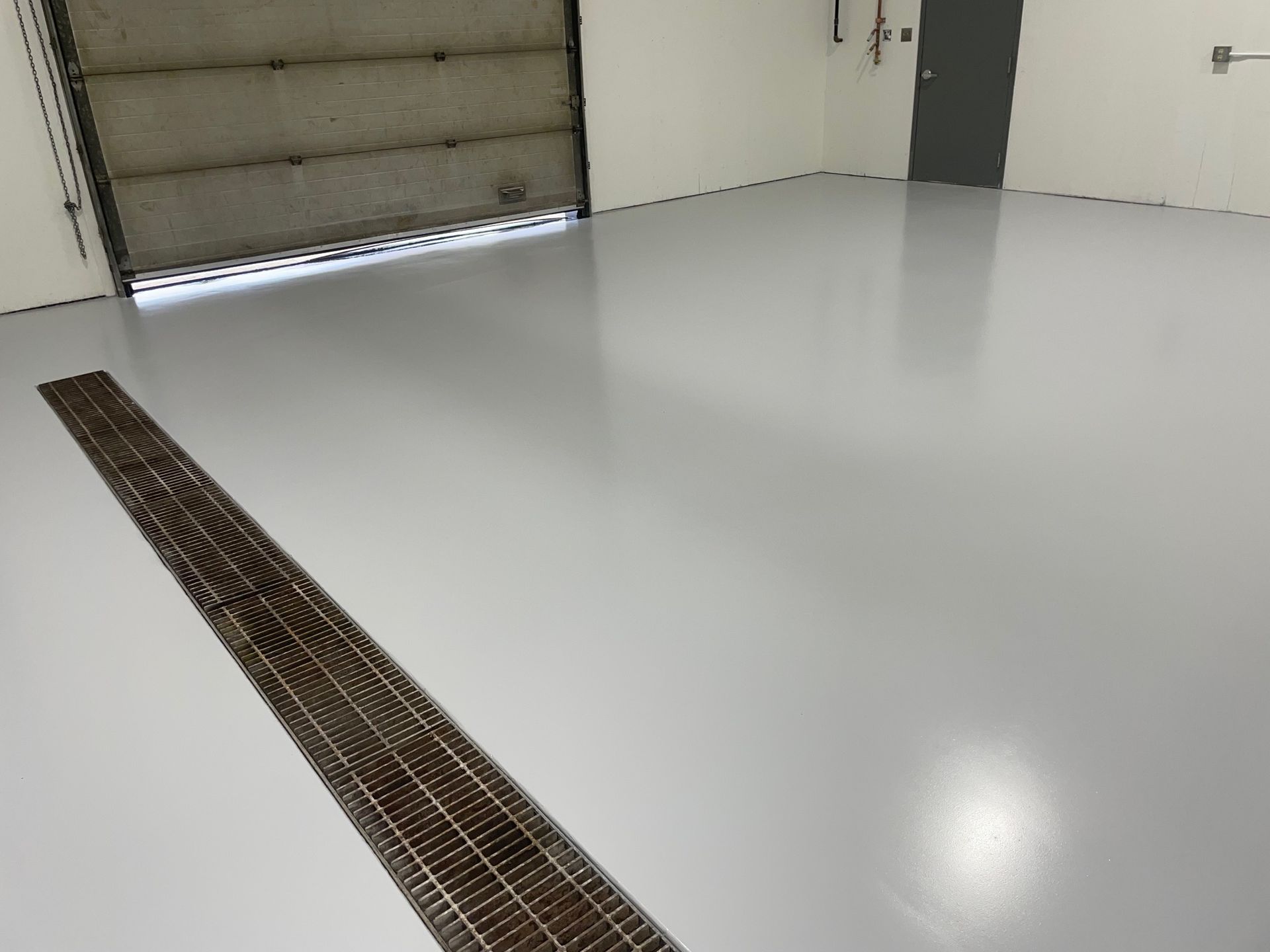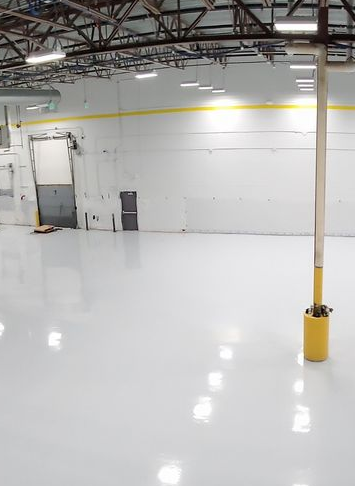


Epoxy Flooring FAQs
-
What is epoxy flooring?
Epoxy flooring is a durable, protective coating made from a two-part system: resin and hardener. When combined, they chemically bond to your substrate (current floor such as concrete, gypcrete, tile, or wood), creating a smooth but extremely tough, anti-skid satin finish.
Epoxy floors are ideal for homes, garages, workshops, shops, and even commercial and industrial spaces because they resist stains, chemicals, and everyday wear. When installed correctly, an epoxy floor is both functional and visually appealing, giving you a surface that is durable and easy to clean.
-
Can epoxy be applied over existing floors?
Yes, epoxy can be applied over a variety of existing surfaces, including concrete, gypcrete, tile, and wood - even previously coated floors. The key is proper surface preparation.
The existing floor must be properly prepped according to the manufacturer's product data. This includes crack filling, joint filling, treating any oil spots if needed, and mechanically profiling (via diamond grinding or shot blasting) This ensures the epoxy bonds correctly. Skipping these steps can lead to peeling, bubbling, or uneven coverage.
If a floor has a previous coating or paint on it, this is removed by grinding before installing epoxy.
-
How long does it take for epoxy to cure?
Curing time depends on the product type, temperature, and humidity. Most epoxy floors are walkable within 24 hours and can be driven on in 48 hours. However, one should avoid turning tires sharply. Full chemical resistance and maximum hardness takes 7 days.
As professional installers, we monitor environmental factors closely to ensure the floor has cured appropriately so that your floor performs optimally.
-
Are epoxy floors slippery?
Epoxy floors can be slippery, particularly when wet. This is why we recommend using an anti-slip topcoat to improve traction. Glossy epoxies are known to be slippery.
We encourage our clients to choose a satin finish anti-skid option. This still reflects light very well and vastly improves safety.
-
How do I maintain my epoxy floor?
Maintenance is simple compared to uncoated concrete. Regular sweeping or vacuuming prevents dirt from scratching the surface, and occasional mopping with a neutral detergent keeps the floor looking new.
Avoid harsh chemicals or acidic cleaners, which can degrade the epoxy over time. A properly installed floor also reduces the need for resealing or refinishing, saving you time and money in the long run.
-
How long does epoxy flooring last?
Epoxy floors are extremely durable. In residential settings, properly installed floors can last over 20 years, while commercial or industrial floors typically last 10–20 years depending on traffic and how well they're cared for.
Longevity depends on proper surface prep, correct application, and environmental conditions. This is why professional installation is so important, especially in climates like Alaska where moisture affects the concrete.
Epoxy Flooring FAQs

-
What is epoxy flooring?
Epoxy flooring is a durable, protective coating made from a two-part system: resin and hardener. When combined, they chemically bond to your substrate (current floor such as concrete or tile), creating a smooth but extremely tough, anti-skid satin finish.
Epoxy floors are ideal for garages, workshops, shops, and even commercial and industrial spaces because they resist stains, chemicals, and everyday wear. When installed correctly, an epoxy floor is both functional and visually appealing, giving you a surface that is durable and easy to clean.
-
Can epoxy be applied over existing floors?
Yes, epoxy can be applied over a variety of existing surfaces, including concrete, gypcrete, tile, and wood. The key is proper surface preparation.
The existing floor must be properly repped according to manufacturer's product data - cleaned, repaired, and mechanically profiled (via grinding or shot blasting) to ensure the epoxy bonds correctly. Skipping these steps can lead to peeling, bubbling, or uneven coverage.
-
How long does it take for epoxy to cure?
Curing time depends on the product type, temperature, and humidity. Most epoxy floors will be walkable within 24 hours and ready for light use in 24–48 hours. Full chemical resistance and maximum hardness typically develop within 72 hours.
As professional installers, we monitor environmental factors closely to ensure the floor has cured appropriately so that you floors performs optimally.
-
Are epoxy floors slippery?
Epoxy floors can be slippery, particularly when wet. This is why we use an anti-slip topcoat to improve traction. Glossy epoxies are known to be slippery.
We encourage our clients to choose a satin finish anti-skid option. This still reflects light very well and vastly improves safety.
-
How do I maintain my epoxy floor?
Maintenance is simple compared to uncoated concrete. Regular sweeping or vacuuming prevents dirt from scratching the surface, and occasional mopping with mild detergent keeps the floor looking new.
Avoid harsh chemicals or acidic cleaners, which can degrade the epoxy over time. A properly installed floor also reduces the need for resealing or refinishing, saving you time and money in the long run.
-
How long does epoxy flooring last?
Epoxy floors are extremely durable. In residential settings, properly installed floors can last over 20 years, while commercial or industrial floors typically last 10–20 years depending on traffic and how well they're cared for.
Longevity depends on proper surface prep, correct application, and environmental conditions. This is why professional installation is so important, especially in climates like Alaska where moisture affects the concrete.


Epoxy Flooring FAQs
-
What is epoxy flooring?
Epoxy flooring is a durable, protective coating made from a two-part system: resin and hardener. When combined, they chemically bond to your substrate (current floor such as concrete or tile), creating a smooth but extremely tough, anti-skid satin finish.
Epoxy floors are ideal for garages, workshops, shops, and even commercial and industrial spaces because they resist stains, chemicals, and everyday wear. When installed correctly, an epoxy floor is both functional and visually appealing, giving you a surface that is durable and easy to clean.
-
Can epoxy be applied over existing floors?
Yes, epoxy can be applied over a variety of existing surfaces, including concrete, gypcrete, tile, and wood. The key is proper surface preparation.
The existing floor must be properly repped according to manufacturer's produ ct data - cleaned, repaired, and mechanically profiled (via grinding or shot blasting) to ensure the epoxy bonds correctly. Skipping these steps can lead to peeling, bubbling, or uneven coverage.
-
How long does it take for epoxy to cure?
Curing time depends on the product type, temperature, and humidity. Most epoxy floors will be walkable within 24 hours and ready for light use in 24–48 hours. Full chemical resistance and maximum hardness typically develop within 72 hours.
As professional installers, we monitor environmental factors closely to ensure the floor has cured appropriately so that you floors performs optimally.
-
Is it necessary to test my concrete for moisture?
Moisture vaporing (moving) through concrete is one of the biggest causes of epoxy failure. That’s why a proper 72-hour calcium chloride test is essential for every slab-on-grade concrete floor. If there is a crawl space or another room beneath the slab, testing is not necessary.
This test measures the amount of moisture vapor transmission (MVT) at the time of testing. It's a snapshot in time. During very wet seasons, it could be higher. The maximum amount of MVT standard epoxies are warranted for is 3lbs. Many floors we test are above that limit and require the use of an MVT primer. This is critical in Alaska’s unique climate.
Skip testing and your floor could peel or bubble prematurely, because high MVT will cause the epoxy to disbond.
-
Are epoxy floors slippery?
Epoxy floors can be slippery, particularly when wet. This is why we use an anti-slip topcoat to improve traction. Glossy epoxies are known to be slippery.
We encourage our clients to choose a satin finish anti-skid option. This still reflects light very well and vastly improves safety.
-
How do I maintain my epoxy floor?
Maintenance is simple compared to uncoated concrete. Regular sweeping or vacuuming prevents dirt from scratching the surface, and occasional mopping with mild detergent keeps the floor looking new.
Avoid harsh chemicals or acidic cleaners, which can degrade the epoxy over time. A properly installed floor also reduces the need for resealing or refinishing, saving you time and money in the long run.
-
How long does epoxy flooring last?
Epoxy floors are extremely durable. In residential settings, properly installed floors can last over 20 years, while commercial or industrial floors typically last 10–20 years depending on traffic and how well they're cared for.
Longevity depends on proper surface prep, correct application, and environmental conditions. This is why professional installation is so important, especially in climates like Alaska where moisture affects the concrete.